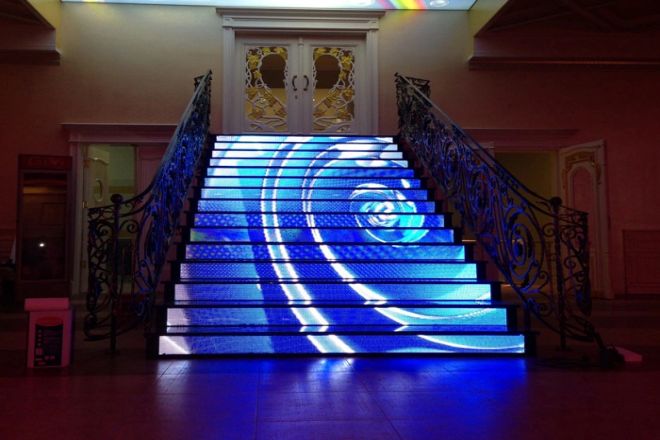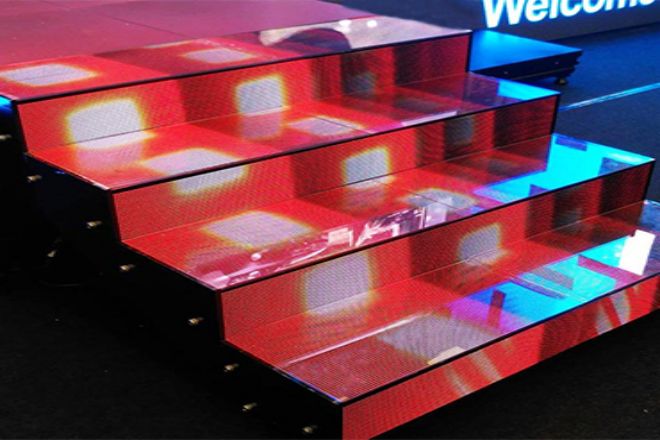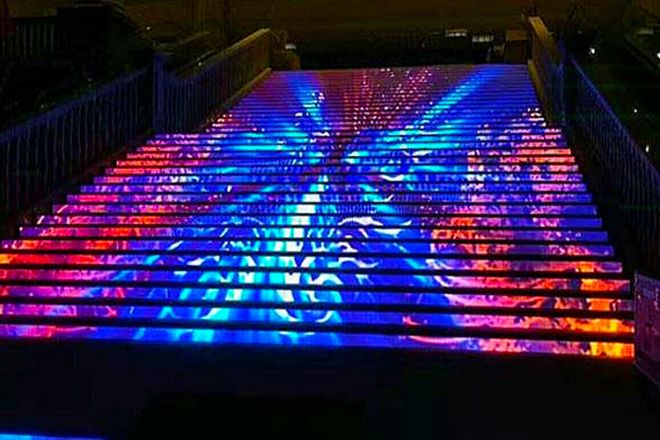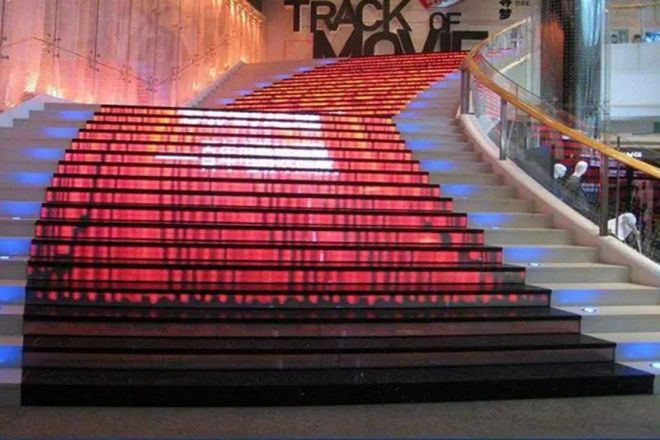Introduction

En tant qu'élément de circulation vertical dans un bâtiment, les escaliers n'ont pas seulement pour fonction de relier les étages, mais deviennent également l'intersection des lignes de vision et de mouvement en raison de leur forme et de leur position uniques.
L’intégration d’écrans d’affichage LED dans la conception d’escaliers n’est pas seulement une tentative audacieuse d’utiliser l’espace, mais aussi une exploration profonde de la profondeur de l’intégration de l’art et de la technologie.
Imaginez que chaque pas d'ascension s'accompagne de changements de lumière et d'ombre, et que chaque arrêt puisse ressentir le flux d'informations. Cet article vous emmènera à la découverte des possibilités infinies de écrans d'affichage LED au sol dans cette nouvelle scène d'escalier, et révélez comment elle remodèle l'espace de l'escalier.
1. Tous les escaliers peuvent-ils être installés avec des écrans d’affichage LED au sol ?

Tous les escaliers ne peuvent pas être équipés d'écrans d'affichage LED au sol. De nombreux facteurs doivent être pris en compte lors de l'installation d'écrans d'affichage LED au sol dans les escaliers, notamment, mais sans s'y limiter, les points suivants :
1). Limitations spatiales et structurelles :
La largeur, la hauteur, la profondeur et la capacité de charge de l'escalier auront une incidence sur l'installation de l'écran d'affichage à LED. L'écran d'affichage a besoin de suffisamment d'espace pour être installé, et son poids et sa méthode d'installation doivent assurer la stabilité et la sécurité de la structure de l'escalier.
L'écran d'affichage LED au sol nécessite une alimentation électrique stable. Lors de l'installation d'un écran d'affichage dans une cage d'escalier, il est nécessaire d'évaluer la disposition des lignes électriques et l'adéquation de la capacité électrique pour garantir que l'écran d'affichage puisse fonctionner normalement.
3). Facteurs de sécurité :
Les escaliers sont des zones où le personnel circule fréquemment, les facteurs de sécurité sont donc cruciaux. L'installation de l'écran d'affichage doit être solide et fiable pour éviter les blessures corporelles dues à une chute ou à un basculement.
Dans le même temps, la luminosité et la répartition de la lumière de l’écran d’affichage doivent également être raisonnablement conçues pour éviter les interférences visuelles ou les risques pour la sécurité des piétons.
4). Conditions d'utilisation et coûts :
Lors de l'installation d'un écran d'affichage LED au sol dans les escaliers, les exigences d'utilisation spécifiques et la rentabilité sont également prises en compte. Si la fréquence d'utilisation de la zone d'escalier est faible ou si l'effet d'affichage n'est pas requis, l'installation de l'écran d'affichage peut ne pas être rentable.
5). Réglementations et réglementations :
Dans certaines zones ou certains endroits spécifiques, il peut exister des réglementations concernant l'installation d'écrans d'affichage LED. Avant l'installation, il est nécessaire de comprendre et de respecter ces réglementations pour garantir la conformité.
En résumé, bien que l'application d'écrans d'affichage LED au sol dans les escaliers soit créative et attrayante, tous les escaliers ne sont pas adaptés à l'installation. Dans les applications réelles, une évaluation et une prise de décision complètes sont nécessaires en fonction des circonstances spécifiques.
Si les escaliers répondent aux conditions d'installation et présentent des besoins d'utilisation clairs et des avantages économiques, l'installation d'un écran LED au sol sera un bon choix.
2. Pourquoi s'agit-il d'un écran LED au sol et d'autres écrans LED ne sont pas possibles ?
La raison pour laquelle l'utilisation d'écrans LED au sol dans les escaliers est privilégiée est principalement due à ses avantages et caractéristiques uniques, qui sont difficiles à remplacer par d'autres types d'écrans LED. Voici quelques raisons clés :
1). Caractère unique du lieu d'installation et des performances :
L'écran LED au sol est le seul parmi de nombreux écrans LED qui peut être installé au sol et sur lequel les gens peuvent marcher. C'est la raison pour laquelle l'écran LED installé dans les escaliers doit l'être.
2). Adaptabilité spatiale :
En tant qu’espace de circulation vertical, la forme et la structure de l’escalier présentent certaines particularités.
L'affichage LED au sol peut être personnalisé en fonction de la forme et de la taille spécifiques de l'escalier pour garantir un ajustement parfait à la structure de l'escalier sans occuper trop d'espace supplémentaire.
Ce haut degré d'adaptabilité spatiale fait de l'écran LED au sol un choix idéal pour la décoration des escaliers et l'affichage d'informations.
3). Interactivité :
Certains écrans LED au sol prennent en charge les fonctions tactiles ou de détection et peuvent interagir avec les piétons.
En installant cet écran d'affichage dans les escaliers, vous pouvez concevoir divers liens interactifs intéressants, comme la lecture de musique et de vidéos sur l'écran tactile, ou l'affichage de différents contenus en détectant les mouvements des piétons.
Cette interactivité augmente non seulement le plaisir des escaliers, mais renforce également le sentiment de participation et d’expérience des piétons.
4). Portance et stabilité :
En tant que zone avec un flux de personnel fréquent, les escaliers ont des exigences élevées en matière de portance et de stabilité de l'écran d'affichage. Les écrans d'affichage LED au sol sont généralement fabriqués à partir de matériaux à haute résistance et présentent d'excellentes propriétés de portance et de résistance aux chocs.
Dans le même temps, sa structure d'installation a également été soigneusement conçue pour assurer la stabilité et la sécurité en cas d'utilisation à long terme et de pas fréquents.
3. Quels sont les avantages de l’installation d’écrans d’affichage LED au sol dans les escaliers ?

L'installation d'écrans d'affichage LED au sol dans les escaliers apporte de nombreux avantages, dont principalement les aspects suivants :
1). Améliorez les effets visuels et la beauté spatiale :
L'écran d'affichage LED au sol peut améliorer considérablement les effets visuels de la zone d'escalier grâce à sa haute luminosité, Haute définition et couleurs vives. Il peut transformer les escaliers en un espace d'affichage dynamique et vivant, ajoutant une sensation de modernité et de technologie à l'environnement global.
En diffusant de belles images, vidéos ou animations, les écrans LED peuvent créer une atmosphère unique, faisant des escaliers un point d'attraction et rehaussant la beauté de l'espace global.
2). Améliorer l’efficacité de la transmission des informations :
En tant que zone très fréquentée, l'installation d'écrans LED peut transmettre efficacement diverses informations, telles que des guides d'étage, des conseils de sécurité, des promotions d'événements, etc.
Ces informations sont présentées aux piétons de manière intuitive et vivante, améliorant ainsi l’efficacité et la précision de la transmission des informations.
Pour les lieux commerciaux, les écrans LED peuvent également être utilisés pour afficher du contenu publicitaire, attirer l'attention des clients et améliorer l'image de marque et les performances de vente.
3). Améliorer l’expérience utilisateur et l’interactivité :
Certains écrans LED au sol prennent en charge les fonctions tactiles ou de détection, qui peuvent interagir avec les piétons.
En concevant des liens interactifs intéressants, comme toucher l’écran pour écouter de la musique et des vidéos ou participer à des jeux, le sentiment de participation et d’expérience de l’utilisateur peut être amélioré.
Cette interactivité augmente non seulement le plaisir des escaliers, mais permet également aux utilisateurs de se divertir et de se détendre pendant qu'ils attendent ou marchent, améliorant ainsi la satisfaction globale des utilisateurs.
4). Améliorer l’utilisation de l’espace :
L'espace dans les escaliers est généralement limité, mais l'installation d'écrans LED au sol peut utiliser pleinement cet espace pour l'affichage et la promotion.
Par rapport aux affiches, bannières et autres méthodes publicitaires traditionnelles, les écrans d'affichage LED ont une capacité de transport d'informations plus élevée et de meilleurs effets visuels et peuvent permettre une diffusion d'informations plus efficace dans un espace limité.
5). Promouvoir la construction de l’image de marque et la communication culturelle :
Pour les entreprises, centres commerciaux, ou des institutions culturelles, les escaliers peuvent être équipés d'écrans d'affichage LED au sol comme plate-forme publicitaire importante. L'affichage d'une image de marque, de concepts culturels ou d'informations sur un événement peut approfondir la connaissance et la mémoire du public de l'entreprise et promouvoir la construction de la marque et la communication culturelle.
6). Améliorer la sécurité :
Lors de certaines occasions spéciales, comme une évacuation d'urgence, les écrans d'affichage à LED peuvent également diffuser des instructions d'urgence pour guider la foule vers une évacuation ordonnée. Cette fonction améliore non seulement la sécurité, mais reflète également le côté pratique et l'importance des écrans d'affichage à LED.
4. Combien coûte l'installation d'un écran d'affichage LED au sol dans les escaliers ?
Le coût d'installation d'un écran LED au sol dans les escaliers sera affecté par de nombreux facteurs, il est donc impossible de donner un chiffre précis. Cependant, la fourchette de prix peut être estimée approximativement en fonction de certains facteurs d'influence courants. Voici quelques-uns des principaux facteurs affectant le coût :
1). Taille de l'écran d'affichage et résolution:
Plus l'écran d'affichage est grand, plus il faut de perles de lampe LED et plus le coût est élevé.
Plus la résolution est élevée, plus l'effet d'affichage est clair, mais cela augmentera également le coût.
Par conséquent, la largeur et la hauteur des escaliers ainsi que l'effet d'affichage requis affecteront directement la taille et la sélection de la résolution de l'écran d'affichage, puis affecteront le coût total.
2). Technologie et qualité de l'écran d'affichage :
Différentes technologies d'écran d'affichage LED (telles que CMS, ÉPI, etc.) et les niveaux de qualité (tels que la qualité des perles de lampe, le système de contrôle, etc.) affecteront le prix.
Les écrans d'affichage de haute qualité et de haute technologie ont généralement de meilleurs effets d'affichage, une durée de vie plus longue et des taux de défaillance plus faibles, mais le prix augmentera également en conséquence.
3). Difficulté et coût d'installation :
La forme, la structure et l’environnement environnant de l’escalier peuvent affecter la difficulté et le coût de l’installation.
Si la forme de l'escalier est complexe, l'espace est limité ou une méthode d'installation spéciale (comme le levage, la fixation, etc.) est requise, le coût d'installation peut augmenter.
4). Autres coûts :
Outre le coût de l’écran d’affichage lui-même, le coût des équipements de support tels que l’alimentation électrique, le système de contrôle, la ligne de transmission et le support de montage doit également être pris en compte.
De plus, si des services de conception, de construction, de mise en service et d’autres services sont impliqués, les frais de service correspondants doivent être payés.
5. Comment entretenir l'écran d'affichage LED au sol dans les escaliers ?

L'entretien de l'écran d'affichage LED au sol dans les escaliers est un élément important pour assurer son fonctionnement stable à long terme et prolonger sa durée de vie. Voici quelques étapes et précautions d'entretien clés :
1). Inspection quotidienne
- Vérifiez l'apparence de l'écran :
Vérifiez régulièrement la surface de l’écran pour détecter d’éventuelles rayures, fissures ou bosses.
Vérifiez s'il y a des objets étrangers attachés à l'écran, tels que de la poussière, des gouttelettes d'eau, etc.
- Vérifiez les lignes de connexion :
Assurez-vous que tous les câbles d’alimentation et de signal sont fermement connectés sans se desserrer ni tomber.
Vérifiez si les lignes sont endommagées, vieillies ou comportent des pièces métalliques exposées.
- Vérifiez le système de refroidissement :
Le système de refroidissement de l'écran est essentiel à son fonctionnement stable. Vérifiez si le ventilateur, le dissipateur thermique et les autres composants fonctionnent correctement pour assurer une bonne dissipation de la chaleur.
2). Nettoyage régulier
- Nettoyage de la surface de l'écran :
Essuyez délicatement la surface de l’écran avec un chiffon doux et sec ou un chiffon sans poussière pour éliminer la poussière et la saleté.
N'utilisez pas de détergents ou de chiffons humides contenant des produits chimiques pour essuyer l'écran afin d'éviter d'endommager son revêtement de surface ou de provoquer des courts-circuits internes.
- Nettoyage des composants internes :
Si vous devez nettoyer les composants internes de l'écran (tels que les circuits imprimés, les pilotes, etc.), assurez-vous de le faire sous la direction de professionnels et assurez-vous que l'opération est effectuée hors tension.
3). Mise sous et hors tension correcte
- Séquence de mise sous tension :
Tout d’abord, allumez l’appareil de contrôle (tel qu’un ordinateur, un contrôleur, etc.), puis allumez l’écran LED une fois qu’il fonctionne normalement.
- Séquence d'arrêt :
Éteignez d'abord l'écran LED, puis éteignez l'appareil de commande. Assurez-vous de couper l'alimentation de l'écran et d'attendre un moment avant d'éteindre l'écran pour permettre au circuit interne de se décharger complètement.
4). Évitez les écrans à haute luminosité à long terme
L'affichage à haute luminosité à long terme accélère le vieillissement des perles de lampe LED et réduit la durée de vie de l'écran. Par conséquent, lorsqu'il n'est pas nécessaire, la luminosité de l'écran doit être réduite de manière appropriée ou désactivée.
5). Contrôle environnemental
- Température et humidité :
Maintenez la température et l'humidité de l'environnement dans lequel se trouve l'écran dans une plage appropriée. Évitez d'utiliser l'écran pendant une longue période dans un environnement à température et humidité élevées.
- Étanche à la poussière et à l'eau :
L'écran doit être étanche à la poussière et à l'eau. S'il doit être utilisé à l'extérieur, assurez-vous que l'écran dispose de fonctions étanches à l'eau et à la poussière, et nettoyez régulièrement la poussière environnante et l'eau accumulée.
6). Entretien et réparation professionnels
- Entretien régulier :
Effectuez régulièrement des opérations d'entretien et de réparation professionnelles en fonction de l'utilisation de l'écran et des recommandations du fabricant. Cela comprend la vérification des connexions des circuits, le remplacement des composants vieillissants, le réglage des effets d'affichage, etc.
- Réparation professionnelle :
Si l'écran tombe en panne ou présente des phénomènes anormaux (luminosité inégale, distorsion des couleurs, scintillement, etc.), contactez à temps un professionnel pour effectuer la réparation et l'entretien. Ne démontez pas et ne réparez pas vous-même les pièces internes de l'écran afin d'éviter de provoquer des dommages plus importants ou des risques pour la sécurité.
Conclusion
Avec l'avancement continu de la technologie et l'extension illimitée de la créativité, l'affichage LED au sol dans les escaliers devient progressivement une nouvelle carte de visite de la culture urbaine, conduisant à une nouvelle tendance d'affichage de l'espace et de diffusion de l'information.
Ils donnent non seulement une nouvelle vitalité à l'élément traditionnel des escaliers, mais améliorent également de manière invisible l'expérience esthétique et la qualité de vie du public.
Enfin, si vous souhaitez en savoir plus sur l’affichage LED au sol, veuillez nous contacter.
